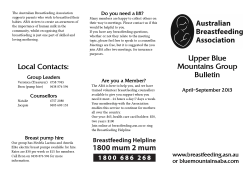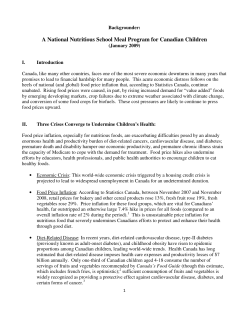
Working Group on Nutrition 24 June, 2011 Ministry Of Women & Child Development Government of India
Working Group on Nutrition 24 June, 2011 Presented by Dr. Shreeranjan, Joint Secretary Ministry Of Women & Child Development Government of India 1 Structure of Presentation 1. Situation Analysis 2. Action Taken and in process 3. Issues & Challenges 2 Situation Analysis : Children • Every fifth child in the world lives in India • 22 % babies are born with low birth weight • 50 out of 1000 live births do not complete their first year of life • 42.5% of children 0‐5 years are underweight • 79% children (6‐35 months) are anaemic • Prevalance of Bitot Spots in 0.6% preschool children Source : NFHS-3, 2005-06 Child Undernutrition % Children Under-3 years Note: Using WHO 2006 International Reference population Infant and Young Child Feeding Practices * ** Note : NFHS-1 data available for infants 0-3 mths (exclusively breast-fed) * NFHS-2 data: 0-3 months **NFHS-3 data: 0-5 months-5 months & 29 days Children‐ Denied Nurture From Nature… Exclusive Breastfeeding in India (0-6 months) 100% Not Breastfeeding Percentage 80% Breastmilk+comple mentary foods Breastmilk and non milk liquids Breastmilk + other milk Breastmilk + water 60% 40% 20% Exclusive Breastfeeding 0% <2 months 2-3 months 4-5 months Age Source: NFHS-3, 2005-06 Anaemia Prevalence in Children % of children age 6-35 months Source- NFHS 3 2005-06, NFHS 2 1997-98 Children with diarrhoea who received ORS (%) (NFHS 3) 32.7 26.9 26.2 42 24.0 17.8 52.5 34.7 35.6 24.8 34.4 33.5 31.9 12 16 22.2 NFHS 1 NFHS 2 NFHS 3 67.7 NFHS 3 -Urban NFHS 3 - Rural 17.8 28.6 28.3 42 37.8 36 51.6 31 34.6 29 41.3 43.7 13.3 17.1 36.8 58.3 51.2 Situation Analysis : Women • More than a third (36%) of women have a BMI below 18.5 ; among women who are thin, 44% are moderately or severely thin • 36.0% women suffer with Chronic Energy Deficiencies • 56.2% women are anaemic • Women suffer from a dual burden of malnutrition with nearly half of them being either too thin or overweight • The percentage of ever‐married women age 15‐49 who are overweight or obese increased from 11 percent in NFHS‐2 to 15 percent in NFHS‐3 • As undernutrition decreases, overnutrition increases by about the same amount • Undernutrition declines and overnutrition increases with age of women Source : SRS Bulletin 2011, IIPS, NFHS-3, 2005-06, SRS Special Bulletin on Maternal Mortality in India 2004-06 (April 2009) NFHS 3 Nagaland UP Bihar Arunachal MP Rajasthan Manipur Jharkhand Assam Meghalaya Tripura Chattisgarh INDIA West Bengal Mizoram Punjab Uttaranchal J&K Haryana Maharashtra Orissa Gujarat Delhi Himachal Andhra Sikkim Karnataka Tamil Nadu Goa Kerala Mothers who consumed IFA for 90 days or more when pregnant with last child 90 80 70 60 50 40 30 20 10 0 Situation Analysis : Adolescent Girls • 11-18 years Adolescent Girls (AGs): Approx. 8.32 cr. - (16.75 % of female population) • Undernourished AGs: Approx. 2.75 cr. (33% of 8.32 cr.) • Anaemic : 56 % • 58 % women married and 30% gave first birth before age of 18 years contributing to High MMR and anaemia • Drop out rate (I-X): 63.5% [Mass Education, MDM] • Malnutrition levels are higher among young girls. Almost half of the girls in age 15-19 are undernourished Investing in nutrition & development of AGs- Imperative to address Intergenerational cycle of undernutrition Malnutrition : Multi‐ faceted, complex & intergenerational Child Undernutrition Inadequate Dietary Intake Lack of Household Food Security Manifestations Disease/ Infections Inadequate Care for Care for Women and Children Women and Children Immediate determinants Inadequate access to Health Childcare Services & Underlying determinants Hygienic Environment Lack of Information Education Communication Lack of Resources & Control Human, Economic & Organisational Basic determinants Political and Ideological Superstructure Economic Structure Potential resource base Source: Adapted from UNICEF 12 Action taken & in process • Bringing Nutrition as front agenda through Joint paper , multilayered consultations & PM Council meeting and follow up actions • ICDS Universalization : enhancing cost & nutrition norm including provision for morning snack & hot cooked meal (3‐6 y) • Fortified food for under 3 and P&L women as THR • Introduction of WHO Growth Standards • Joint MCP Card • Updated IYCF Guidelines • APIP of ICDS indicating nutrition status, gaps and needs • Conceptualising and establishing Nutrition Resource Platform • Approval of SABLA on ICDS platform • Approval of IGMSY Action taken & in process Decision to start Double fortified salt in Govt. feeding programs Bringing nutrition focus in sectoral programs Several States launching/ initiating process for Nutrition Mission Decision to launch nationwide IEC campaign Decision to initiate multi‐sectoral focussed action in 200 high burden districts • VHSC transformed to include nutrition ‐ VHSNC • Enhanced support and mobilisation of development partners • NRHM ‐ initiated MTC & NRCs ; free maternal and new born care for first thirty days Janani Shishu Suraksha Karyakram (JSSK) • • • • • • Several direct & indirect program expanded Challenge of Intergenerational cycle of survival, growth & development • Early and frequent pregnancy • Improper child spacing • Physical stress & depletion • Inadequate care during pregnancy • Inadequate foetal nutrition Low Birth Weight Undernourished Mothers • Early marriage, Early and frequent pregnancy with Improper child spacing • Poor diet & Inadequate care during pregnancy, Anemia • Physical stress & depletion Undernourished, Less aware , vulnerable Adolescent girls • Inadequate child care • Improper IYCF practices • Inadequate food, nutrition and health care • Burden of disease, infections • Anemia • Inadequate catch up and growth • Inadequate education • Gender discrimination at home • Lack of Awareness Existing Interventions Target Group SCHEMES Pregnant and Lactating Mothers Children 0 – 3 ICDS, RCH‐ II, NRHM, JSY, Indira Gandhi Matritva Sahyog Yojana (IGMSY) – The CMB Scheme Children 3 – 6 ICDS, RCH‐ II, NRHM, ICPS, Rajiv Gandhi National Creche Scheme, Total Sanitation Campaign (TSC), National Rural Drinking Water Programme (NRDWP) Mid Day Meals (MDM), Sarva Shiksha Abhiyan (SSA), ICPS School going children 6 – 14 Adolescent Girls 11 – 18 Adults ICDS, RCH‐ II, NRHM, ICPS, Rajiv Gandhi National Creche Scheme Expansion NRHM (2005‐06) JSY (2006‐07) ICDS (2008‐09) RGNCS (2005‐06) ICDS (2008‐09) TSC (2008‐09) SSA (2002/2005‐ 06) MDM (2008‐09) Rajiv Gandhi Scheme for the Empowerment of Adolescent Girls NRDWP (2010) (RGSEAG), Kishori Shakti Yojana, , Total Sanitation Campaign (TSC), RGSEAG (2010‐11) National Rural Drinking Water Programme (NRDWP), ICPS MGNREGS, NRLM, Skill Development Mission, Women Welfare NHM (2005‐06) and Support, Programme, Adult Literacy Programme, TPDS, AAY, MGNREGS (2005‐ Old and Infirm Persons Annapurna, Rashtriya Krishi Vikas Yojana, 06) Food Security Mission, Safe Drinking Water and Sanitation NRLM(2010‐11) Programmes, National Horticulture Mission, National Iodine NIDDCP (1992) Deficiency Disorders Contol Programme (NIDDCP), Nutrition RSBY (2007) Education and Extension, Bharat Nirman, Rashtriya Swasthya Bima Bharat Nirman Yojana (2005) Existing Interventions: Continuum of Care (Life Cycle Approach) ICDS+ IGMSY P&L mothers SABLA MDM ICDS 11 – 18 yrs Girls 6 – 14 yrs ICDS Exclusive Breastfeeding 0 ‐ 6 months 3 – 6 yrs 6 months – 3 yrs Breastfeeding & Complementary Feeding Livelihoods + Income IEC + BCC Flagship and Bharat Nirman Programmes Food Security + Health & Child Care Services + Water & Sanitation+ Caring Practices FOUNDATION OF CHILD CARE AND DEVELOPMENT APPROACH Issues & Challenges • Governance and Political Commitment – State Nutrition Council – State Nutrition Action Plan – Action Plan for High Burden Districts • Investing more financial & human resource for nutrition • Bringing strong nutrition focus in Ministries/departments dealing with Health, Drinking Water Supply and Sanitation, School Education, Agriculture and Food & Public Distribution etc. • Convergence of Multi Sectoral & theme based Actions • Making Development Sectors: Results Focused, Convergent, Decentralized, Flexible • Extending from centre based to family & individual based nutrition education and care • Strengthening and Restructuring of ICDS: infrastructure, technical support, additional nutrition counselor • Effective Implementation and Delivery of Quality Services through Community Participation of all concerned programs including ICDS Issues & Challenges • Priority to New Born, < 3s and High Burden Districts • Promotion of IYCF, partnerships with institutions (BPNI ) • Establishing protocol for community based rehabilitation and home based care of undernourished children • Continuum of care – addressing intergenerational cycle of malnutrition: RGSEAG (SABLA) & IGMSY Ensuring household food security (proposed food security bill) • • Effective Result Oriented Monitoring, Greater Accountability and Nutrition Surveillance & Mapping (NNMB to cover all states) • Nutrition & Health Education: Communication, BCC, IEC & Use of ICT • Human Resource Development, Professional Cadre, Voluntary Action Groups & Capacity Building Scaling up Evidence Based Approaches: A Challenge • Maternal & child undernutrition, underlying cause of > 1/3rd of all < 5 child deaths is preventable: –Critical window of opportunity for prevention: Pregnancy to age 24 months –Early initiation & exclusive breastfeeding: can prevent 1/5th of neonatal mortality –Exclusive breastfeeding for the first six months and appropriate complementary feeding after 6 months: can prevent 1/5th of child mortality (< 5) –Available nutrition interventions, implemented at scale: can reduce 1/4th of child deaths in the short term –Addressing iron deficiency & anaemia: can avert 1/5th of maternal mortality • Evidence based direct nutrition interventions: –Promote good nutrition practices including improved hygiene practices –Increase intake of vitamins & minerals including vitamin A, Zinc and IFA supplements, iodized salt & de‐worming drugs –Provision of micronutrient through food fortification –Prevention and treatment of severe undernutrition Early Preventive Action is Critical Note –NFHS 3 - Using WHO 2006 International Reference population THANK YOU 22
© Copyright 2025





















